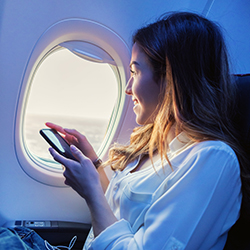Fixing In-Flight Wi-Fi
By: Tiago Rodrigues

Think about the last time your Internet connection went out at home or at work. It probably didn’t take more than a few panicky minutes before you started to feel less productive and cut off from
the rest of the world. And when your connection was restored, it gave you a newfound appreciation of just how much you rely on the Internet.
So, it’s surprising how every day, millions of people give up connectivity for hours on end simply because they’ve boarded a plane. That’s a problem for some passengers and airlines alike, but
the good news is that Wi-Fi can be as available in the air as it is on the ground.
One reason is that the business foundation is already there. For over a decade, airlines around the world have offered in-flight Internet connectivity to passengers as a premium service. In
recent years, faster, higher bandwidth satellite connections and cellular-based air-to-ground networks have steadily lowered the cost of providing in-flight service. This trend should help make
in-flight Wi-Fi a mass-market service, something that most travelers use rather than just businesspeople who can expense it.
Even so, many passengers still don’t use it. Why?
Why it’s so hard to get and stay connected
One major hurdle is difficulty connecting due to the traditional captive portal method. Passengers must connect to the service set identifier (SSID), then navigate to the landing page, and
finally register and pay. It’s as tedious as the airport security screening gauntlet. But unlike security, frustrated passengers can opt out of using in-flight Wi-Fi—and often do.
In an online journey, each incremental step usually leads to a 50 percent dropout. Most dropouts due to this unnecessarily complex connection process are lost revenue, direct or indirect, for ecosystem members: airlines, mobile operators, satellite, air-to-ground backhaul services, avionics vendors, and hub services that facilitate roaming.
For business travelers, another common barrier is their employer’s virtual private network (VPN). Once they’re connected to the aircraft’s Wi-Fi network, connecting to their VPN subsequently
blocks access to onboard services such as in-flight entertainment (IFE). To regain access, they must disconnect their VPN. This back-and-forth makes them less likely to purchase premium in-flight
services—another revenue loss for airlines and their business partners.
To understand how these barriers can be overcome, it helps first to understand the nuts and bolts of how smartphones, tablets, and other devices get connected. The onboard Wi-Fi service
facilitates the device’s connection to the aircraft wireless local area network (WLAN), which then provides access to onboard services such as in-flight entertainment and internet access. This
sounds straightforward, but it isn’t. That’s because currently there is no consistent, industry-standard method for devices to get associated with the in-flight system. In fact, the association
process differs not only by airline, but also for each flight segment within the same airline.
What leisure and business travelers want—and deserve—is seamless, effortless, gate-to-gate connectivity. As soon as they board the aircraft, their device should automatically gain access to the
airline’s Wi-Fi network and services such as IFE and Internet connectivity, and then maintain all that until they disembark at their destination.
How to clear in-flight Wi-Fi for takeoff
Fortunately, there is an industry-standard framework that the airline ecosystem can use to facilitate this vision. It’s called OpenRoaming, and it’s in wide use worldwide. That means the airline
ecosystem can assess its business value right now and implement it immediately instead of reinventing the wheel.
OpenRoaming was developed by dozens of equipment manufacturers, service providers, and other Wi-Fi ecosystem members under the auspices of the Wireless Broadband Alliance. WBA is an international organization focused on business and



















